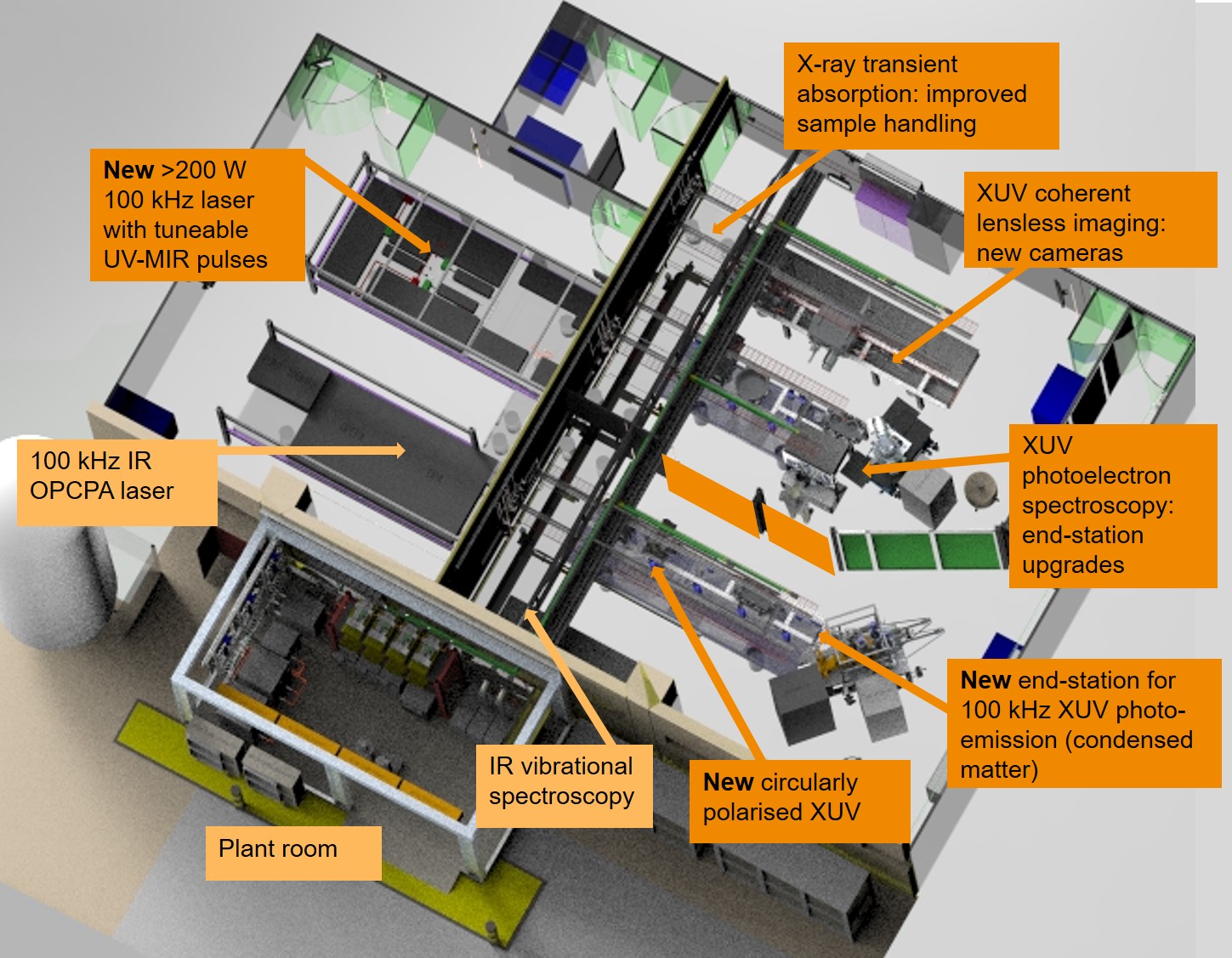HiLUX will be housed within the CLF’s existing footprint in the Research Complex at Harwell. It will provide a new generation of multi-kHz lasers, detectors, sample handling technologies and efficient handling of large data sets. A 10-100 fold increase in average power of lasers will drive new “secondary light sources” that can span THz to XUV. A hundred-fold increase in laser repetition rate and data rate will unlock new science applications and greatly reduce timescales to results. HiLUX will provide national-scale facilities for training of young scientists, and will complement UK and international university infrastructure, synchrotron and XFEL large-scale facilities.
The fast motion of atoms and molecules lie at the heart of almost all aspects of human life. From industrial catalysis, or devices to capture and store green energy through to the enzymes that affect our body functions, all rely on the rearrangement of electrons, chemical bonds and molecular structure on timescales spanning attoseconds (10-18 s) to seconds or longer. Advanced laser based spectroscopic techniques, manifest in capabilities pioneered at the STFC Central Laser Facility (CLF) at Harwell and its partnership with UK academia, have been at the global vanguard of elucidating information and understanding in such chemical systems and environments for several decades. We have though reached a natural limit, simply due to our existing technology, that means only relatively simple systems can be studied. Now however, enabled by recent developments in advanced laser, detector and computational technology, there is a unique opportunity to overcome this limit and extend our techniques into greater real-world complex systems through this HiLUX proposal. This brings with it the potential to impact on many areas of scientific, economic, and societal importance and in so doing secures the international leadership of the UK in this area of science into the next decade.
XUV instrumentation
- New 200-500 W Ytterbium-based 100 kHz laser system, providing <50 fs pulses at 1 micron with high stability. This will replace the 1 kHz Artemis Ti:Sapphire system.
- The 100 kHz OPCPA system, producing pulses at 1700 nm and 3000 nm, will be retained.
- Tuneable pulses to cover the 200 nm – 20 micron spectral range.
- Tuneable, isolated XUV pulses in the 20 eV to 100 eV range, with ~10 micron and ~100 micron spot-sizes.
- Photo-emission spectroscopy, with tuneable pump and XUV probe. Upgraded UHV end-station. Options under consideration include momentum microscope, hemispherical analyser and spin-resolution for PEEM and ARPES on devices in operando and 10 micron-scale samples.
- Photo-electron spectroscopy on gas and liquid samples, with tuneable pump and XUV probe. Upgrades to spectrometer and detector to enable both ion and electron detection, and covariance measurements.
- X-ray transient absorption, with gas, liquid (thin) jet and solid samples.
- XUV ptychography, with element specific-imaging to 13 nm and high rep-rate cameras.
- Capabilities for studies of magnetic systems, including circularly polarised XUV, spin detection, time-resolved MOKE.

Proposed layout of the Artemis XUV labs with HiLUX facility upgrades
Transformation in ultrafast Infrared, Raman
and UV- Near IR Spectroscopy Capabilities
- World leading transient absorption spectrometer that will capture the entire mid-IR fingerprint region on each laser shot. This will capture molecule dynamics from <100 femtoseconds to seconds on one instrument.
- World leading sensitivity Kerr-Gated Raman spectrometer. This will offer 30x faster acquisition than existing spectrometers, acquiring spectra in seconds instead of minutes and allowing Kerr-Gated Raman imaging.
- Next generation of high repetition rate, broad bandwidth 2DIR spectroscopy.
- New 2D-Electronic spectroscopy (2DES) capability, offering < 10 fs resolution with spectral coverage across the whole visible spectrum.
- Comprehensive provision of vibrational surface sum frequency generation.
- Flexible platform for development and new analytical applications of non-linear spectroscopies.
Proposed layout of the Ultra IR spectroscopy labs with HiLUX facility upgrades
Data acquisition and management
HiLUX will address the need for rapid data acquisition and visualisation software at the user/operator interface, and for local and remote data visualisation and analysis capability during and after experiments. It will utilise CLF and STFC Scientific Computing Department’s data curation and archive data provision to provide a data and analysis portal. This will enable remote access to data and custom visualisation packages via virtual PC. The rapid data handling will provide new scope to adopt “compressive sensing” and correlative referencing approaches to speed data acquisition and increase signal to noise. The large datasets will enable use of AI and machine learning techniques. Integrated and intelligent rapid sample change and control platforms will match the high acquisition rates.
Samples
The sample range will include gases, solutions, solids, surfaces, 2D materials, crystals and device structures. Sample stage position control will be linked to data acquisition systems, enabling intelligent raster control adapted to sample characteristics and automated analysis on multiple samples. New imaging capability will be opened up by rapid scanning techniques.
To enable TRMPS on fs to seconds timescales, there will be synchronised stop-go movement of samples using fast translation stages or microfluidics. Spectro-electrochemical flow cells and heterogeneous catalysis cells will be available. Fast laser based nanosecond T-Jump and up to >100 degC microsecond T-Jump will be available on the any of the spectrometers.
For studies of in-vacuum samples, HiLUX will provide thin liquid jets and continuous flow gas nozzles. Capability to study in operando devices, and 10-micron scale samples will be provided. Sample preparation, analysis, cooling and heating capability will be expanded.
Job vacancies
We will be advertising for at least three ultrafast scientists as part of the project.
Contacts
